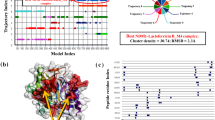Abstract
Discovering and developing the antimicrobial peptides are recently focused on pharmaceutical firm, since they serve as complementary to antibiotics in prevailing over drug resistance by eliciting the disruption of microbial membrane. Still, there are lots of challenges to bring up the structurally stable and functionally efficient antimicrobial peptides. It is well known that gramicidin D is the prominent antimicrobial peptide that exists as g-AB, g-BC, and g-AC. This study analyzes the structural stability and the functional activity of hetero-dimeric double-stranded gramicidin-D peptides, thereby demonstrating its potent antimicrobial activity against antibiotic-resistant micro-organisms. To investigate the structural stability and functionality of gramicidin D, we performed static and dynamic analysis. Initially, we observed a maximum number of intermolecular interactions and membrane penetration in g-AB as compared to g-BC and g-AC. To substantiate further, the geometrical and thermodynamic parameters revealed the retention of maximum stability in g-AB than g-AC and g-BC. Thus, the conformational free energy and the binding free energy showed the variation among gramicidin-D peptides for the prediction of increased stability and functionality. In conclusion, g-AB peptide has definitely demonstrated adequate structural stability and functionality and this work will need to be considered in peptide-based drug discovery.







Similar content being viewed by others
References
Gold HS, Moellering RCJ (1996) Antimicrobial-drug resistance. N Engl J Med 335(19):1445–1453
Ventola CL (2015) The antibiotic resistance crisis. Pharm Ther 40(4):277–283
Liou J-W, Hung Y-J, Yang C-H, Chen Y-C (2015) The antimicrobial activity of gramicidin a is associated with hydroxyl radical formation. PLoS One [Internet] 10(1):e0117065
Arenas I, Villegas E, Walls O, Barrios H, Rodríguez R, Corzo G (2016) Antimicrobial activity and stability of short and long based arachnid synthetic peptides in the presence of commercial antibiotics. Molecules 21(2):225
Carvalho CA, Olivares-Ortega C, Soto-Arriaza MA, Carmona-Ribeiro AM (2012) Interaction of gramicidin with DPPC/DODAB bilayer fragments. Biochim Biophys Acta BBA Biomembr 1818(12):3064–3071
Olczak A, Główka ML, Szczesio M, Bojarska J, Wawrzak Z, Duax WL (2010) The first crystal structure of a gramicidin complex with sodium: high-resolution study of a nonstoichiometric gramicidin D-NaI complex. Acta Crystallogr D Biol Crystallogr 66(Pt 8):874–880
Bourinbaiar AS, Coleman CF (1997) The effect of gramicidin, a topical contraceptive and antimicrobial agent with anti-HIV activity, against herpes simplex viruses type 1 and 2 in vitro. Arch Virol 142(11):2225–2235
Kelkar DA, Chattopadhyay A (2007) The gramicidin ion channel: a model membrane protein. Biochim Biophys Acta BBA Biomembr 1768(9):2011–2025
Wimley WC (2010) Describing the mechanism of antimicrobial peptide action with the interfacial activity model. ACS Chem Biol 5(10):905–917
Sarkar N, Langley D, Paulus H (1977) Biological function of gramicidin: selective inhibition of RNA polymerase. Proc Natl Acad Sci USA 74(4):1478–1482
Strandberg E, Özdirekcan S, Rijkers DTS, van der Wel PCA, Koeppe RE, Liskamp RMJ, Killian JA (2004) Tilt angles of transmembrane model peptides in oriented and non-oriented lipid bilayers as determined by 2H solid-state NMR. Biophys J 86(6):3709–3721. https://doi.org/10.1529/biophysj.103.035402
Kajava AV, Steven AC (2006) β‐rolls, β‐helices, and other β‐solenoid proteins. Adv Protein Chem 73:55–96. https://doi.org/10.1016/S0065-3233(06)73003-0
Yang Z, Domach M, Auger R, Yang FX, Russell AJ (1996) Polyethylene glycol-induced stabilization of subtilisin. Enzyme Microb Technol 18(2):82–89
Ketchem RR, Lee KC, Huo S, Cross TA (1996) Macromolecular structural elucidation with solid-state NMR-derived orientational constraints. J Biomol NMR 8(1):1–14
Townsley LE, Tucker WA, Sham S, Hinton JF (2001) Structures of gramicidins A, B, and C incorporated into sodium dodecyl sulfate micelles. Biochemistry (Mosc) 40(39):11676–11686
Burkhart BM, Gassman RM, Langs DA, Pangborn WA, Duax WL (1998) Heterodimer formation and crystal nucleation of gramicidin D. Biophys J 75(5):2135–2146
Berman HM, Westbrook J, Feng Z, Gilliland G, Bhat TN, Weissig H et al (2000) The protein data bank. Nucleic Acids Res 28(1):235–242
Pei J, Kim B-H, Grishin NV (2008) PROMALS3D: a tool for multiple protein sequence and structure alignments. Nucleic Acids Res 36(7):2295–2300
Krieger E, Vriend G (2014) YASARA View—molecular graphics for all devices—from smartphones to workstations. Bioinformatics 30(20):2981–2982
Krieger E, Vriend G (2015) New ways to boost molecular dynamics simulations. J Comput Chem 36(13):996–1007
Krieger E, Nielsen JE, Spronk CAEM, Vriend G (2006) Fast empirical pKa prediction by Ewald summation. J Mol Graph Model 25(4):481–486
Tina KG, Bhadra R, Srinivasan N (2007) PIC: protein interactions calculator. Nucleic Acids Res 35(Web Server):W473–W476
Seeliger D, De Groot BL (2009) tCONCOORD-GUI: visually supported conformational sampling of bioactive molecules. J Comput Chem 30(7):1160–1166
Seeliger D, Groot BL de (2010) Conformational transitions upon ligand binding: holo-structure prediction from apo conformations. PLOS Comput Biol 6(1):e1000634
Pedretti A, Villa L, Vistoli G (2004) VEGA—an open platform to develop chemo-bio-informatics applications, using plug-in architecture and script programming. J Comput Aided Mol Des 18(3):167–173
Van Der Spoel D, Lindahl E, Hess B, Groenhof G, Mark AE, Berendsen HJC (2005) GROMACS: fast, flexible, and free. J Comput Chem 26(16):1701–1718
Humphrey W, Dalke A, Schulten K (1996) VMD: visual molecular dynamics. J Mol Graph 14(1):33–38 (27–8)
Yahyavi M, Falsafi-Zadeh S, Karimi Z, Kalatarian G, Galehdari H (2014) VMD-SS: a graphical user interface plug-in to calculate the protein secondary structure in VMD program. Bioinformation 10(8):548–550
Zhou H, Zhou Y (2009) Distance-scaled, finite ideal-gas reference state improves structure-derived potentials of mean force for structure selection and stability prediction. Protein Sci 11(11):2714–2726
Liu S, Zhang C, Zhou H, Zhou Y (2004) A physical reference state unifies the structure-derived potential of mean force for protein folding and binding. Proteins Struct Funct Bioinform 56(1):93–101
Lomize MA, Pogozheva ID, Joo H, Mosberg HI, Lomize AL (2012) OPM database and PPM web server: resources for positioning of proteins in membranes. Nucleic Acids Res 40(D1):D370–D376
Käll L, Krogh A, Sonnhammer ELL (2004) A combined transmembrane topology and signal peptide prediction method. J Mol Biol 338(5):1027–1036
Kruskal WH (1952) A nonparametric test for the several sample problem. Ann Math Stat 23(4):525–540
Gilis D, Rooman M (1996) Stability changes upon mutation of solvent-accessible residues in proteins evaluated by database-derived potentials. J Mol Biol 257(5):1112–1126
Senthilkumar B, Meshachpaul D, Sethumadhavan R, Rajasekaran R (2015) Selection of effective and highly thermostable Bacillus subtilis lipase A template as an industrial biocatalyst-A modern computational approach. Front Biol 10(6):508–519
Lobanov MY, Bogatyreva NS, Galzitskaya OV (2008) Radius of gyration as an indicator of protein structure compactness. Mol Biol 42(4):623–628
Unsworth LD, van der Oost J, Koutsopoulos S (2007) Hyperthermophilic enzymes—stability, activity and implementation strategies for high temperature applications: properties and applications of hyperthermozymes. FEBS J 274(16):4044–4056
Palm K, Luthman K, Ungell A-L, Strandlund G, Artursson P (1996) Correlation of drug absorption with molecular surface properties. J Pharm Sci 85(1):32–39
Palm K, Stenberg P, Luthman K, Artursson P (1997) Polar molecular surface properties predict the intestinal absorption of drugs in humans. Pharm Res 14(5):568–571
Zhang C, Liu S, Zhu Q, Zhou Y (2005) A knowledge-based energy function for protein–ligand, protein–protein, and protein–DNA complexes. J Med Chem 48(7):2325–2335
Lee J, Im W (2007) Restraint potential and free energy decomposition formalism for helical tilting. Chem Phys Lett 44(1):132–135
Baoukina S, Monticelli L, Tieleman DP (2013) Interaction of pristine and functionalized carbon nanotubes with lipid membranes. J Phys Chem B 117(40):12113–12123
Gangupomu VK, Capaldi FM (2011) Interactions of carbon nanotube with lipid bilayer membranes. J Nanomater 30:e830436
Śledź P, Caflisch A (2018) Protein structure-based drug design: from docking to molecular dynamics. Curr Opin Struct Biol 48:93–102. https://doi.org/10.1016/j.sbi.2017.10.010
Wang S-H, Yu J (2018) Structure-based design for binding peptides in anti-cancer therapy. Biomaterials 156:1–15. https://doi.org/10.1016/j.biomaterials.2017.11.024
Sliwoski G, Kothiwale S, Meiler J, Lowe EW (2014) Computational methods in drug discovery. Pharmacol Rev 66(1):334–395. https://doi.org/10.1124/pr.112.007336
Talele TT, Khedkar SA, Rigby AC (2010) Successful applications of computer aided drug discovery: moving drugs from concept to the clinic. Curr Top Med Chem 10(1):127–141
Van Drie JH (2007) Computer-aided drug design: the next 20 years. J Comput Aid Mol Des 21(10–11):591–601. https://doi.org/10.1007/s10822-007-9142-y
Vijayakrishnan R (2009) Structure-based drug design and modern medicine. J Postgrad Med 55(4):301–304. https://doi.org/10.4103/0022-3859.58943
Hartman GD, Egbertson MS, Halczenko W, Laswell WL, Duggan ME, Smith RL, Naylor AM, Manno PD, Lynch RJ (1992) Non-peptide fibrinogen receptor antagonists. 1. Discovery and design of exosite inhibitors. J Med Chem 35(24):4640–4642. https://doi.org/10.1021/jm00102a020
Acknowledgements
The authors thank VIT for providing ‘VIT SEED Grant’ for carrying out this research work.
Author information
Authors and Affiliations
Corresponding author
Rights and permissions
About this article
Cite this article
Pavithrra, G., Rajasekaran, R. Identification of Effective Dimeric Gramicidin-D Peptide as Antimicrobial Therapeutics over Drug Resistance: In-Silico Approach. Interdiscip Sci Comput Life Sci 11, 575–583 (2019). https://doi.org/10.1007/s12539-018-0304-5
Received:
Revised:
Accepted:
Published:
Issue Date:
DOI: https://doi.org/10.1007/s12539-018-0304-5




